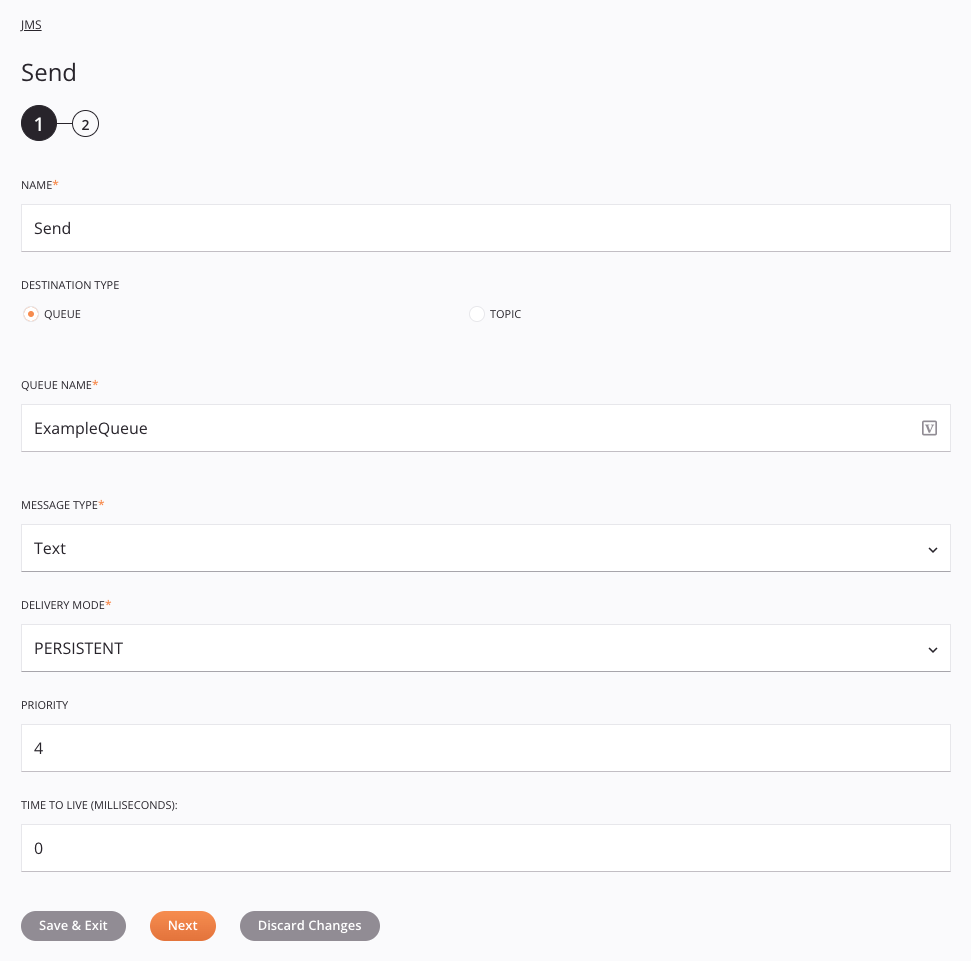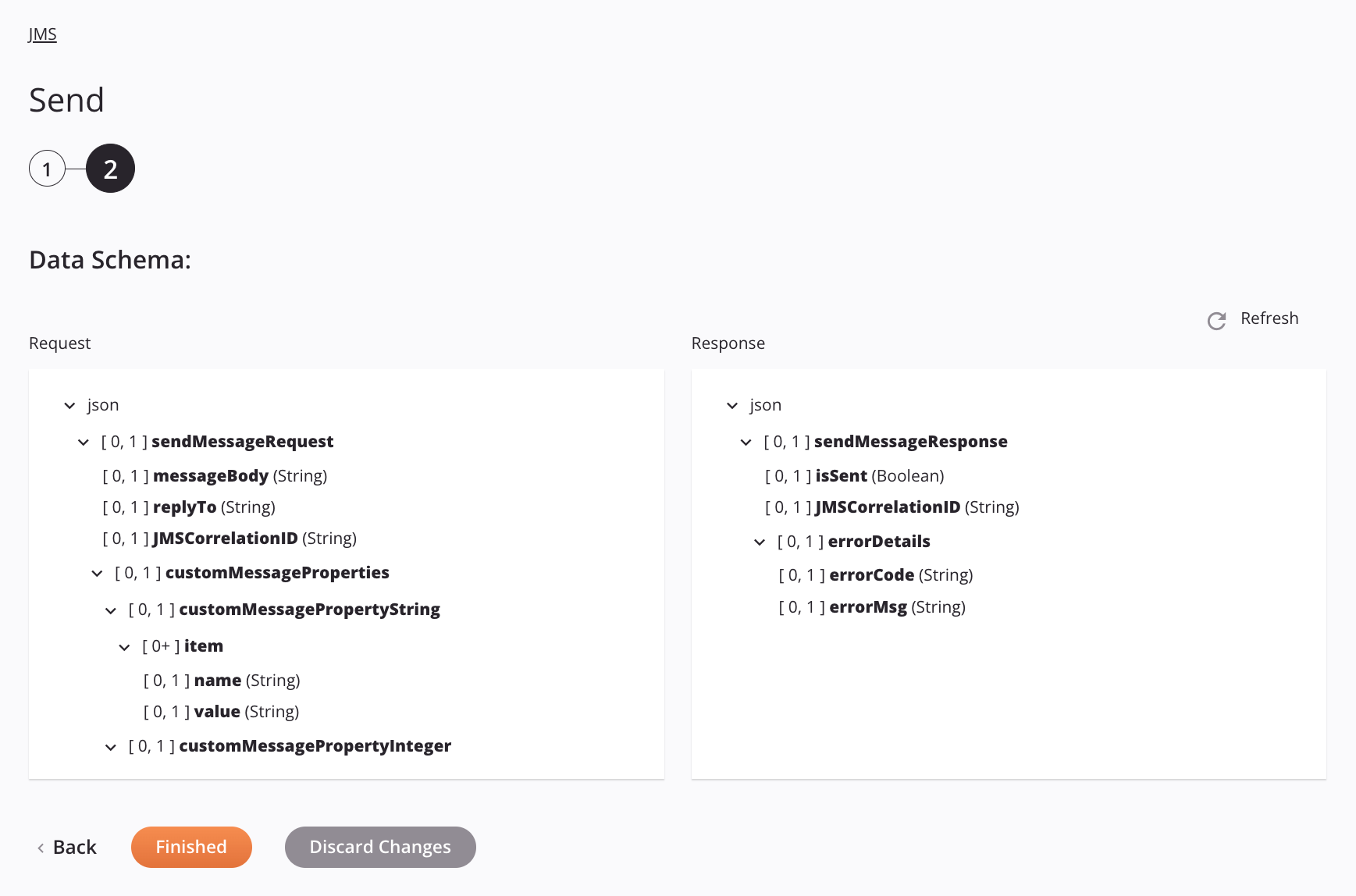JMS Send activity¶
Introduction¶
A JMS Send activity, using its JMS connection, sends messages to a JMS queue or topic and is intended to be used as a target in an operation.
Create a JMS Send activity¶
An instance of a JMS Send activity is created from a JMS connection using its Send activity type.
To create an instance of an activity, drag the activity type to the design canvas or copy the activity type and paste it on the design canvas. For details, see Creating an activity instance in Component reuse.
An existing JMS Send activity can be edited from these locations:
- The design canvas (see Component actions menu in Design canvas).
- The project pane's Components tab (see Component actions menu in Project pane Components tab).
Configure a JMS Send activity¶
Follow these steps to configure a JMS Send activity:
-
Step 1: Enter a name and specify settings
Provide a name for the activity and specify the settings for the messages being sent. -
Step 2: Review the data schemas
Any request or response schemas generated from the endpoint are displayed.
Step 1: Enter a name and specify settings¶
In this step, provide a name for the activity and specify the settings for the messages being sent. Each user interface element of this step is described below.

Tip
Fields with a variable icon ![]() support using global variables, project variables, and Jitterbit variables. Begin either by typing an open square bracket
support using global variables, project variables, and Jitterbit variables. Begin either by typing an open square bracket [ into the field or by clicking the variable icon to display a list of the existing variables to choose from.
-
Name: Enter a name to identify the activity. The name must be unique for each JMS Send activity and must not contain forward slashes
/or colons:. -
Destination Type: Select the destination of the messages being sent, one of Queue or Topic.
-
Queue: Select to send a message to a queue.
-
Topic: Select to send a message to a topic.
-
-
Queue Name / Topic Name: Depending on the Destination Type, enter the name of the queue or topic where the message is to be sent.
Note
When using IBM MQ as the JMS provider, the Queue Name or Topic Name must match the name of an existing queue or topic in the IBM MQ instance or an error will occur. When using Active MQ as the JMS provider, a queue or topic will be created if there is not an existing queue or topic with a name matching the entered name.
-
Message Type: Specify the message type to be used, one of Text or Byte.
-
Delivery Mode: Specify the delivery mode to be used, one of Persistent or Non-persistent. If Persistent is selected, messages are persisted to a disk or database so that they will survive a broker restart. If Non-persistent is selected, all in-transit messages are lost during a broker restart.
-
Priority: Enter the priority of the message using whole numbers from
0(lowest) to9(highest). The default value is4. -
Time to Live (Milliseconds): Enter the time in milliseconds that the messages should live in the queue or topic. The default value is
0, meaning the message will live in the queue or topic indefinitely. -
Save & Exit: If enabled, click to save the configuration for this step and close the activity configuration.
-
Next: Click to temporarily store the configuration for this step and continue to the next step. The configuration will not be saved until you click the Finished button on the last step.
-
Discard Changes: After making changes, click to close the configuration without saving changes made to any step. A message asks you to confirm that you want to discard changes.
Step 2: Review the data schemas¶
Any request or response schemas generated from the endpoint are displayed. Each user interface element of this step is described below.

-
Data Schemas: These data schemas are inherited by adjacent transformations and are displayed again during transformation mapping.
Note
Data supplied in a transformation takes precedence over the activity configuration.
The request and response data schemas consist of these nodes and fields:
Request Schema Node/Field Description sendMessageRequestNode representing the message request messageBodyThe body of the JMS message replyToThe reply destination JMSCorrelationIDThe correlation ID (if a correlation ID is not entered, one is automatically generated at runtime) customMessagePropertiesNode representing the custom message properties customMessagePropertyStringNode representing the contents of the custom message properties that are in the form of a string itemNode representing the message with custom properties nameThe name of the custom property valueThe value of the custom property customMessagePropertyIntegerNode representing the custom message properties that are in the form of an integer itemNode representing the contents of the custom message properties nameThe name of the custom property valueThe value of the custom property customMessagePropertyFloatNode representing the custom message properties that are in the form of a float itemNode representing the contents of the custom message properties nameThe name of the custom property valueThe value of the custom property customMessagePropertyDoubleNode representing the custom message properties that are in the form of a double itemNode representing the contents of the custom message properties nameThe name of the custom property valueThe value of the custom property customMessagePropertyBooleanNode representing the custom message properties that are in the form of a boolean itemNode representing the contents of the custom message properties nameThe name of the custom property valueThe value of the custom property Response Schema Node/Field Description sendMessageResponseNode representing the response isSentBoolean representing the status of the message with trueindicating that the message was sentJMSCorrelationIDString containing the correlation ID errorDetailsNode representing the error details errorCodeString containing any applicable error code errorMsgString containing any applicable error message -
Refresh: Click the refresh icon
 or the word Refresh to regenerate schemas from the JMS endpoint. This action also regenerates a schema in other locations throughout the project where the same schema is referenced, such as in an adjacent transformation.
or the word Refresh to regenerate schemas from the JMS endpoint. This action also regenerates a schema in other locations throughout the project where the same schema is referenced, such as in an adjacent transformation. -
Back: Click to temporarily store the configuration for this step and return to the previous step.
-
Finished: Click to save the configuration for all steps and close the activity configuration.
-
Discard Changes: After making changes, click to close the configuration without saving changes made to any step. A message asks you to confirm that you want to discard changes.
Next steps¶
After configuring a JMS Send activity, complete the configuration of the operation by adding and configuring other activities, transformations, or scripts as operation steps. You can also configure the operation settings, which include the ability to chain operations together that are in the same or different workflows.
Menu actions for an activity are accessible from the project pane and the design canvas. For details, see Activity actions menu in Connector basics.
JMS Send activities can be used as a target with these operation patterns:
- Transformation pattern
- Two-transformation pattern (as the first or second target)
To use the activity with scripting functions, write the data to a temporary location and then use that temporary location in the scripting function.
When ready, deploy and run the operation and validate behavior by checking the operation logs.